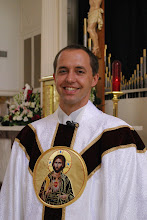

We finally made it to the most Holy Place in Christian tradition, the location of the event on which our faith either stands or falls, Jesus' empty tomb. We had to wait a few minutes as the Franciscan Friars prayed this station of the cross and then were allowed to go into this chapel a few at a time. It was truly amazing to be here! After our visits we celebrated Mass in the "Crusaders Chapel" less than a stones throw away. And of course we celebrated Easter Mass with lots of Alleluias! What a celebration!
Protestants generally do not recognize this site as authentic. They have a place nearby which looks like what the tomb would have looked like, with the roll-away stone, etc. A little history will help explain why this no longer looks like the tomb of Jesus as we might imagine it.
With the Edict of Milan in 313 AD (end of Christian persecution in the Roman Empire), the Christians returned to Jerusalem and to the other holy sites. Emperor Constantine, son of St. Helena, built a complex including a Basilica to include Calvary and a rotunda over the Sepulcher. To do this, he leveled off the sides of Calvary so that it became a balcony. He also cleared the hill away from around the cave of the tomb.
614 AD Assyrians invaded Holy Land and destroyed the Holy Sepulcher.
628 AD, the Muslims conquered Jerusalem
1099 AD The Basilica, as it now stands, was completed by the Crusaders, incorporating elements of the previous Edifices.
1950s restoration began










